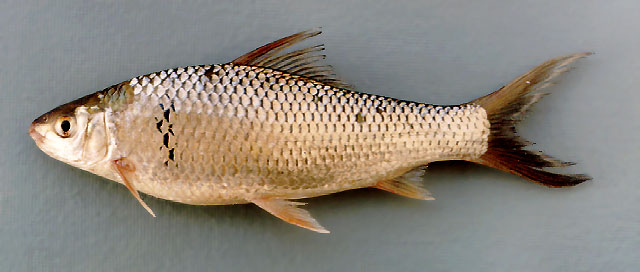| Cyprinidae (Minnows or carps), subfamily: Labeoninae |
| 55 cm TL (male/unsexed); max.weight: 1,487.6 g |
|
benthopelagic; freshwater; depth range 5 - 20 m, potamodromous |
| Asia: Mekong, Chao Phraya, Nam Theun, Xe Bangfai and the Nanpangjiang basins; also from the Red River (China and Viet Nam). |
|
Dorsal spines (total): 0-0; Dorsal soft rays (total): 11-15; Vertebrae: 34-38. Has 37-43 scales on the lateral line (including those on base of caudal-fin); 7-8+1/2 scale rows between lateral line and dorsal-fin origin (Ref. 27732). Differs from all other species of the genus in having more or less discrete marks on each scale on the upper, middle, and sometimes lower parts of the body. Such marks, visible in most freshly caught and recently preserved specimens, are sometimes intensely developed, giving the fish a markedly reticulated appearance. C. molitorella often has a very intense humeral mark which is vivid bluish-green in life. In other Cirrhinus the humeral marks are black or bluish black (Ref. 33488). Usually a conspicuous black bar shortly behind pectoral base (Ref. 43281). Gill rakers on the lower arm of first arch 65-85 (Ref. 12693). |
| Known from midwater to bottom depths of large and medium-sized rivers. Move into flooded forests during the rainy season and grazes on algae, phytoplankton and detritus (Ref. 12693). Occur in rapids and slow deep reaches (Ref. 37769). Reported to be omnivorous (Ref. 33813). Wild stocks are strongly migratory while the cultivated stocks probably have lost the migratory behavior (Ref. 33488). Prefer flowing water and not known to proliferate in impoundments. Large fish are marketed fresh, smaller ones are used to make prahoc (Ref. 12693). Attain at least 40 cm SL (Ref. 33488). |
|
Near Threatened (NT); Date assessed: 19 April 2010 Ref. (130435)
|
| harmless |
|
Occurs in the Mekong, the lower and middle Xe Bangfai, and the lower Nam Theun basins (Ref. 27732). Found in Ban Hang Khone in the middle of the mainstream Mekong River just below the Great Khone Waterfalls in Khong District, Champasak Province (Ref. 37767). Inhabits rapids, slow deep reaches of the Mekong basin at Hat Village, Muang Khong District and makes an upstream non-reproductive migration in December-February and downstream migration in July-August (Ref. 37769 ). Observed to undergo migration and fished heavily at the fishing village of Ban Wernsonkhram on Don Hat (Hat Island) above the Lee Pee Waterfalls (Ref. 10431). Interviews with fishermen strongly suggest that population in Southern Lao Mekong mainstream has declined some 20 or so years ago (Ref. 37769 ). Aquacultural stock reportedly has been introduced from China into the Mekong basin in Laos (Ref. 33488). Also Ref. 4792, 30857, 43281. |
Source and more info: www.fishbase.org. For personal, classroom, and other internal use only. Not for publication.

